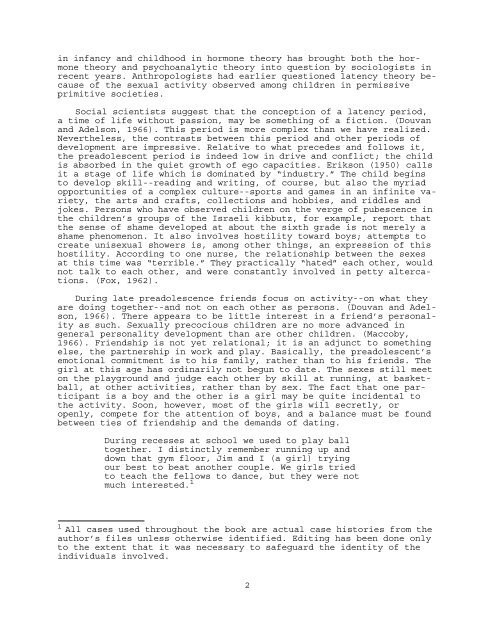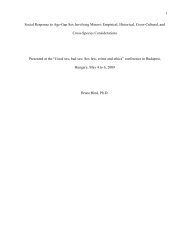Infant and Child Sexuality: A Sociological Perspective - Ipce
Infant and Child Sexuality: A Sociological Perspective - Ipce
Infant and Child Sexuality: A Sociological Perspective - Ipce
Create successful ePaper yourself
Turn your PDF publications into a flip-book with our unique Google optimized e-Paper software.
in infancy <strong>and</strong> childhood in hormone theory has brought both the hormone<br />
theory <strong>and</strong> psychoanalytic theory into question by sociologists in<br />
recent years. Anthropologists had earlier questioned latency theory because<br />
of the sexual activity observed among children in permissive<br />
primitive societies.<br />
Social scientists suggest that the conception of a latency period,<br />
a time of life without passion, may be something of a fiction. (Douvan<br />
<strong>and</strong> Adelson, 1966). This period is more complex than we have realized.<br />
Nevertheless, the contrasts between this period <strong>and</strong> other periods of<br />
development are impressive. Relative to what precedes <strong>and</strong> follows it,<br />
the preadolescent period is indeed low in drive <strong>and</strong> conflict; the child<br />
is absorbed in the quiet growth of ego capacities. Erikson (1950) calls<br />
it a stage of life which is dominated by “industry.” The child begins<br />
to develop skill--reading <strong>and</strong> writing, of course, but also the myriad<br />
opportunities of a complex culture--sports <strong>and</strong> games in an infinite variety,<br />
the arts <strong>and</strong> crafts, collections <strong>and</strong> hobbies, <strong>and</strong> riddles <strong>and</strong><br />
jokes. Persons who have observed children on the verge of pubescence in<br />
the children’s groups of the Israeli kibbutz, for example, report that<br />
the sense of shame developed at about the sixth grade is not merely a<br />
shame phenomenon. It also involves hostility toward boys; attempts to<br />
create unisexual showers is, among other things, an expression of this<br />
hostility. According to one nurse, the relationship between the sexes<br />
at this time was “terrible.” They practically “hated” each other, would<br />
not talk to each other, <strong>and</strong> were constantly involved in petty altercations.<br />
(Fox, 1962).<br />
During late preadolescence friends focus on activity--on what they<br />
are doing together--<strong>and</strong> not on each other as persons. (Douvan <strong>and</strong> Adelson,<br />
1966). There appears to be little interest in a friend’s personality<br />
as such. Sexually precocious children are no more advanced in<br />
general personality development than are other children. (Maccoby,<br />
1966). Friendship is not yet relational; it is an adjunct to something<br />
else, the partnership in work <strong>and</strong> play. Basically, the preadolescent’s<br />
emotional commitment is to his family, rather than to his friends. The<br />
girl at this age has ordinarily not begun to date. The sexes still meet<br />
on the playground <strong>and</strong> judge each other by skill at running, at basketball,<br />
at other activities, rather than by sex. The fact that one participant<br />
is a boy <strong>and</strong> the other is a girl may be quite incidental to<br />
the activity. Soon, however, most of the girls will secretly, or<br />
openly, compete for the attention of boys, <strong>and</strong> a balance must be found<br />
between ties of friendship <strong>and</strong> the dem<strong>and</strong>s of dating.<br />
During recesses at school we used to play ball<br />
together. I distinctly remember running up <strong>and</strong><br />
down that gym floor, Jim <strong>and</strong> I (a girl) trying<br />
our best to beat another couple. We girls tried<br />
to teach the fellows to dance, but they were not<br />
much interested. 1<br />
1<br />
All cases used throughout the book are actual case histories from the<br />
author’s files unless otherwise identified. Editing has been done only<br />
to the extent that it was necessary to safeguard the identity of the<br />
individuals involved.<br />
2
















